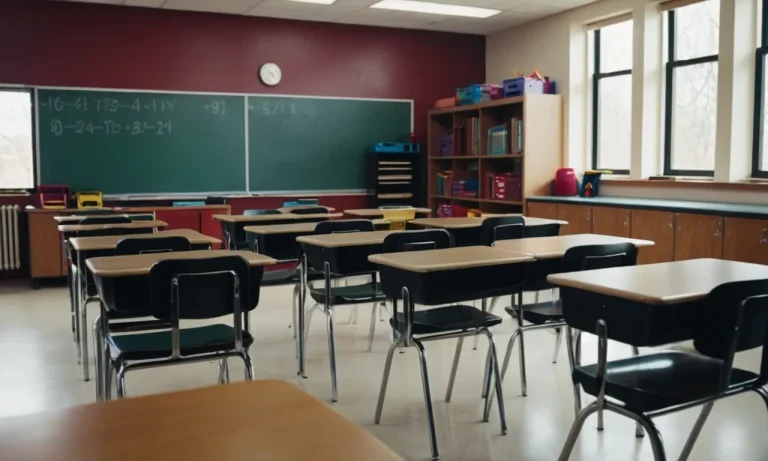Volleyball is a thrilling and fast-paced sport that captivates audiences of all ages. Whether you’re a player, coach, or spectator, understanding the rules and structure of the game is crucial. One of the most frequently asked questions, especially for those new to the sport, is: how many sets in high school volleyball?
If you’re short on time, here’s a quick answer to your question: High school volleyball matches typically consist of the best-of-five sets, with each set played to 25 points (win by 2 clear points).
In this comprehensive article, we’ll delve into the intricacies of high school volleyball sets, exploring the rules, scoring system, and various scenarios that can arise during a match. We’ll also provide insights into the strategies and tactics employed by teams to gain an edge over their opponents.
Understanding the Basics of High School Volleyball Sets
What is a Set in Volleyball?
In volleyball, a set refers to a segment of the game where teams compete to score points until one team reaches the target score. It’s essentially a “race” to see who can accumulate the required number of points first.
A typical high school volleyball match consists of multiple sets, with the team winning the majority of sets (best-of-five format) declared the overall winner. 😎
The Best-of-Five Set Format
Most high school volleyball matches follow a best-of-five set format. This means that the first team to win three sets is declared the match winner. The first four sets are played to 25 points, with a team needing to win by at least two clear points.
If the score is tied at 24-24, play continues until one team gains a two-point advantage. The fifth and deciding set, if necessary, is typically played to 15 points with a minimum lead of two points. According to the National Federation of State High School Associations (NFHS) rules, the fifth set must be won by a two-point margin, with no cap on the maximum score. This format ensures an exciting and competitive match until the very end.
👏
Scoring System and Winning a Set
In high school volleyball, teams score points by grounding the ball on the opponent’s court or when the opposing team commits a fault. Some common faults include:
- Hitting the ball out of bounds
- Catching or holding the ball
- Touching the ball twice in succession (with some exceptions)
- Violating the rules of rotation or position
The scoring system is straightforward – a team scores a point on every rally, regardless of which team served. This “rally scoring” system adds excitement and keeps the game moving at a brisk pace. 🏐
To win a set, a team must be the first to reach the target score (25 points in the first four sets, 15 points in the fifth set) with a two-point advantage. If the score is tied at 24-24 (or 14-14 in the fifth set), play continues until one team gains a two-point lead.
This ensures that every set has a clear winner, avoiding drawn-out games and maintaining the intensity throughout the match. According to the NFHS, in the 2021-2022 season, over 457,000 girls participated in high school volleyball across the United States, showcasing the sport’s immense popularity at the high school level.
🎉
Variations and Exceptions in High School Volleyball Sets
Best-of-Three Set Format
While the traditional best-of-five set format is commonly used in professional and collegiate volleyball matches, high school volleyball often follows a best-of-three set format. This means that the first team to win two sets is declared the winner of the match.
According to the National Federation of State High School Associations (NFHS), this format is widely adopted to accommodate the time constraints and scheduling demands of high school athletics.
In a best-of-three set format, the first two sets are played to 25 points, with a team needing to win by at least two clear points. If the score is tied at 24-24, the set continues until one team gains a two-point advantage.
The third and deciding set, if necessary, is typically played to 15 points, with the same two-point advantage rule in effect. This format ensures that matches are completed within a reasonable time frame, allowing players to balance their academic commitments with their athletic pursuits.
Rally Scoring vs. Sideout Scoring
High school volleyball also differs from higher levels of play in terms of scoring systems. While professional and collegiate volleyball predominantly uses rally scoring, where a point is awarded on every rally regardless of which team served, many high school competitions still utilize sideout scoring.
In sideout scoring, a point is only awarded to the serving team when they win the rally. This scoring system is often favored for its simplicity and tradition, as it has been a staple in volleyball for decades.
However, rally scoring is gradually gaining traction in high school volleyball as well. According to a survey by the NFHS, approximately 60% of high school competitions now use rally scoring, as it is believed to promote more continuous action and faster-paced matches.
The choice between rally scoring and sideout scoring is often determined by state or regional associations, reflecting the diverse preferences and traditions within high school volleyball.
Tie-Breaking Procedures
In the event of a tie at the end of regulation play in a high school volleyball match, various tie-breaking procedures may be employed. The most common method is to play a single “rally game” to 15 points, with the first team to reach 15 points winning the match.
Some states or regions may also use a best-of-three rally game format, where the first team to win two rally games is declared the winner.
Another popular tie-breaking procedure is the “cap” system, where the teams play an additional set to a predetermined cap score, such as 25 or 30 points. The first team to reach the cap score wins the set and, consequently, the match.
This system ensures that matches are resolved within a reasonable timeframe, preventing extended overtime periods that could conflict with academic schedules or facility availability.
Regardless of the specific tie-breaking procedure used, the goal is to determine a clear winner while maintaining the integrity and competitiveness of the match. High school volleyball associations strive to strike a balance between fair play, time constraints, and the unique needs of student-athletes.
Strategies and Tactics for Winning Sets
Winning sets in high school volleyball requires a combination of well-executed strategies and tactics. From serving and receiving to offensive and defensive plays, every aspect of the game contributes to the overall success of a team.
Let’s dive into some crucial elements that can make a significant difference on the court.
Serving and Receiving Strategies
A strong serve can set the tone for the entire rally, putting pressure on the opposing team right from the start. Mastering various serving techniques, such as the float serve, jump serve, and top-spin serve, can keep the opponents guessing and create scoring opportunities.
According to the American Volleyball Coaches Association (AVCA), teams with an effective serving strategy often have a higher chance of winning sets.
On the receiving end, a solid defensive formation and communication are key. Players should be prepared to move quickly and anticipate the trajectory of the serve. Utilizing techniques like overhand passing, forearm passing, and platform passing can help maintain control of the ball and initiate offensive plays.
Practicing serve-receive drills regularly can improve players’ reflexes and increase their chances of winning the rally.
Offensive and Defensive Tactics
Offensive tactics in volleyball revolve around setting up powerful attacks and outmaneuvering the opposing team’s defense. Employing a variety of offensive plays, such as quick attacks, back-row attacks, and combination plays, can keep the defense guessing and create scoring opportunities.
According to a study by the National Center for Biotechnology Information, teams that effectively utilize different offensive strategies tend to score more points and win more sets.
Defensively, teams should focus on solid court coverage, effective blocking, and anticipating the opponents’ offensive plays. Implementing defensive systems like the perimeter defense or rotational defense can help distribute responsibilities and maximize court coverage.
Additionally, practicing read-and-react drills can improve players’ ability to anticipate and respond to attacks, ultimately increasing their chances of winning rallies and sets.
Substitution and Rotation Strategies
Effective substitution and rotation strategies can provide a competitive edge in high school volleyball. Coaches should carefully analyze their players’ strengths and weaknesses, and make strategic substitutions to capitalize on favorable matchups or inject fresh energy into the game.
According to a study by USA Volleyball, teams that effectively utilize substitutions and rotations tend to have a higher win rate in sets.
Rotation strategies, such as the 6-2 or 5-1 offensive systems, can also play a crucial role in maximizing a team’s offensive potential. By strategically positioning players with specific skill sets, coaches can create opportunities for successful attacks and defensive plays.
Regular practice and communication between coaches and players are essential for executing substitution and rotation strategies effectively.
Winning sets in high school volleyball is a multifaceted endeavor that requires a combination of physical skills, mental toughness, and strategic thinking. By mastering serving and receiving strategies, implementing effective offensive and defensive tactics, and utilizing substitution and rotation strategies wisely, teams can increase their chances of success and ultimately achieve their goals on the court.
😊
The Importance of Mental Toughness in High School Volleyball Sets
In the fast-paced and competitive world of high school volleyball, mental toughness is a crucial aspect that often separates the winners from the losers. While physical skills and techniques are undoubtedly essential, the ability to maintain focus, deal with pressure situations, and foster team chemistry and resilience can make all the difference in those intense volleyball sets.
Maintaining Focus and Composure
During a high school volleyball set, there are countless distractions and potential sources of mental fatigue. From the cheering crowds to the pressure of scoring points, it’s easy for players to lose their focus and composure.
However, mentally tough players have the ability to block out these external factors and remain fully present in the moment. According to a study by the NCAA, mentally tough athletes are more likely to stay focused and composed under pressure, which can lead to better decision-making and performance on the court.
Dealing with Pressure Situations
High school volleyball sets are often filled with pressure-packed moments, such as tie-breaking points or game-deciding rallies. In these situations, mental toughness becomes paramount. 😤 Players who can remain calm, confident, and resilient in the face of adversity are more likely to perform at their best when it matters most.
A study by the American Sport Education Program found that mentally tough athletes are better equipped to handle stress, anxiety, and pressure, which can be a game-changer in high-stakes volleyball matches.
Building Team Chemistry and Resilience
Volleyball is a team sport, and mental toughness plays a crucial role in fostering team chemistry and resilience. When players are mentally tough, they are better able to support and encourage each other, even in the face of setbacks or adversity.
This positive team dynamic can create a sense of unity and determination that can propel the team to greater heights. 💪 According to a study by the National Center for Biotechnology Information, mentally tough teams are more likely to bounce back from defeats and maintain a positive attitude, which can be a game-changer in high school volleyball sets.
Conclusion
High school volleyball sets are a crucial aspect of the game, determining the outcome of matches and shaping the strategies employed by teams. By understanding the rules, scoring system, and various scenarios that can arise, players, coaches, and spectators can fully appreciate the intricacies of this exciting sport.
Whether you’re a seasoned veteran or a newcomer to the world of volleyball, this comprehensive guide has provided you with valuable insights into the structure and dynamics of high school volleyball sets.
Armed with this knowledge, you can better enjoy and engage with the sport, whether as a player, coach, or spectator.
Remember, success in high school volleyball sets requires not only physical prowess but also mental toughness, strategic thinking, and a deep understanding of the game’s nuances. Embrace the challenges, stay focused, and strive for excellence – the thrill of victory awaits those who master the art of winning sets.






